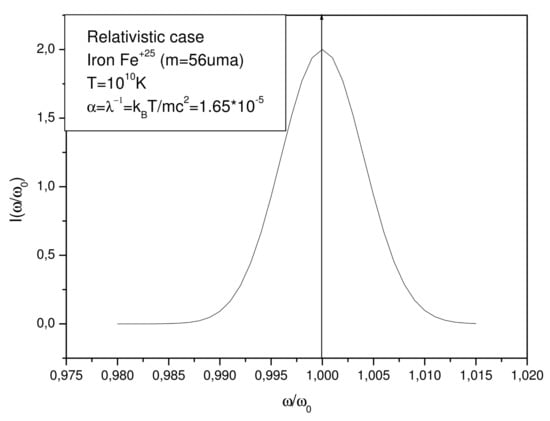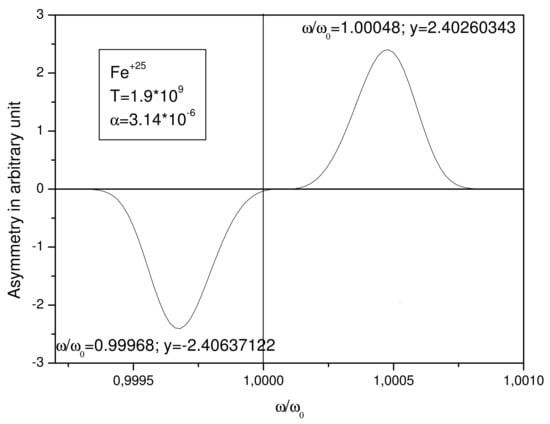Abstract
In this work, we report some relativistic effects on the spectral line broadening. In particular, we give a new Doppler broadening in extra hot plasmas that takes into account the possible high velocity of the emitters. This suggests the use of an appropriate distribution of the velocities for the emitters. Indeed, the Juttner-Maxwell distribution of the velocities is more adequate for relativistic velocities of the emitters when the latter are in plasma with an extra high temperature. We find an asymmetry in the Doppler line shapes unlike the case of the traditional Doppler effect.
1. Introduction
The Doppler effect, discovered by physicist and mathematician Christian Doppler in the nineteenth century, is the modification of the frequency of a wave when the emitting source and the receiver are in relative motion. The frequency change also implies that of the period and the wavelength. This effect concerns both mechanical waves and electromagnetic waves. In plasmas, the neutral atoms, molecules or ions moving inside the plasma are similar to the moving antennae. Atoms or ions subjected to the Doppler effect, exhibit the well-known phenomenon: the Doppler broadening of the line profile. The investigation in recent decades of the derivation and illustration of the Doppler effect, especially the generalized relativistic Doppler effect, is still being actively pursued today [,,,,]. In the following we will illustrate this method to formulate the classical Doppler effect first, and then the same method is formulated to get the relativistic Doppler effect on the Doppler broadening of the line profile. In our work, we will present a better derivation allowing quick and exact expressions of the classic and relativistic Doppler effect on the broadening of the spectral lines observed in the plasmas. In the formulation of the classical Doppler effect, we used the Maxwell velocity distribution for the emitters, while in the formulation of the relativistic Doppler effect we used the relativistic Juttner-Maxwell distribution. The latter is justified for the case of very high temperatures (in the range 10–10 K) such as that encountered in fusion plasmas, in astrophysics, in cosmology (primordial Universe) and in unstable Z Pinch experiments []. Indeed, the Juttner-Maxwell distribution remains valid for all temperatures since it is more general than the Maxwell distribution.
2. Doppler Broadening
2.1. Classical Doppler Broadening: Non Relativistic Case
Often the emission (or absorption) of radiation by a particle (atom, ion, etc.) occurs during the movement. By the Doppler effect, the observed frequency in the observer (at rest) frame (see Figure 1) is different from the frequency emitted in the atom frame. The mean particle velocity at thermodynamic equilibrium is related to the temperature of the medium. Hence the broadening of the statistical Doppler effect is related to the distribution of the velocities of the emitter at the temperature T of the medium and the mass m of the emitter.

Figure 1.
The fixed frame where the emitter moves with a velocity forming an angle with the observation direction Ox.
One can assume a motionless observer, looking at an emitting atom moving with a velocity in a direction forming an angle with the direction of observation (Ox) (see Figure 1), records a shifted angular frequency with respect to the angular eigenfrequency of the emitter assumed to be stationary. This angular frequency is given by
where c is the velocity of the light in vacuum. The normalized intensity (normalized to one) of the line at the angular frequency is given by the average over the normalized Maxwell distribution (normalized to one).
of the Dirac delta distribution as the following
Using the integral representation of the Dirac delta distribution (u is the integration variable whose unit is the second)
We find the normalized intensity (normalized to one) as
where , is the Boltzmann constant and m is the emitter mass. This is the formula of the intensity of the line in the non relativistic case. It is symmetric (Gaussian) around the central angular frequency . We note that the integrals in Formula (6) are strongly convergent because we deal with purely Gaussian integrals. The full width at the half maximum (FWHM) is given by the well known formula (in angular frequency unit)
where M is the mass of the emitter in atomic mass unit whereas T is the temperature in Kelvin.
2.2. Relativistic Doppler Broadening
When an observer at a rest, recording the emitted radiation from a moving atom (or ion) with relativistic velocity , they find that the angular frequency of this radiation is equal to []:
where
and is the angular eigenfrequency and is the angle between the velocity of the emitter and the observation direction () (see Figure 1). By using the normalized Juttner-Maxwell distribution (normalized to one) []
where
and is the modified Bessel function of order two, we obtained the normalized relativistic intensity (normalized to one) of the line profile
Here, we have introduced the integral over the spherical angles that makes the emitter velocity with the fixed frame axis (see Figure 1). We have replaced the Dirac delta distribution by its integral representation by integrating over the variable u. Replacing the Juttner-Maxwell distribution given by (11) and given by (8) in Formula (14), we reach a more suitable expression of the relativistic intensity of the line profile
or after integration on between zero and ;
Finally, the integration over u, allows us to get the relativistic intensity of the line profile
where if and if and is the reduced angular frequency. We can manage the formula to be more suitable for the numerical treatment:
if we put , ( is given by formula (12)) we find
We note that the integral in the last formula is convergent because we deal with the integral in distribution sense [].
Unlike the classical Doppler effect, the relativistic one has a property: an asymmetric broadening as it is shown clearly in the following table corresponding to the temperatures in the range – K. We remark also that in the relativistic case, as in the classical case, the central frequency is unchanged (see Figure 2). The maximum value of the intensity is at both for classical and relativistic case but the maximum value of the relativistic case is smaller than the maximum of the classical case (the asymmetry at ) is negative, see Figure 3.

Figure 2.
Relativistic intensity as defined by Formula (19) for Iron at T = 10 K.

Figure 3.
Asymmetry as defined by Formula (20) for at T = 1.9 × 10 K.
We mention that in the Table 1, we have denoted by the value of the reduced angular frequency at the left and the right of the peak of the line (centred at ). and are chosen to be symmetrical with respect the centre of the line at and giving intensities very close to the half of the maximum of the intensity. Strictly speaking, we have considered and with g = 0.00045 for , 0.00075 for , 0.00085 for (produced in nuclear reactions) and 0.00095 for (it is synthesized in laboratories for use in nuclear reactions). As we see in this table, the value of the intensity at the right is greater than the intensity at the left . This remark shows clearly that the line profile has an asymmetry as defined by [] (see the definition at the last line in the above table). Another feature in this study is that we have not specified the line profile, because we have used the reduced angular frequency : for each specific line (specific transition), we must multiply (the x-axis) by the corresponding angular eigenfrequency to obtain the intensity . If we define the asymmetry as []
which is the difference between the normalized relativistic intensity given by (18) and the normalized classical intensity given by (6), we obtain the following figure representing the asymmetry for at 1.9 × 10 K.

Table 1.
Asymmetry percentages for different hydrogen-like ions.
In Figure 3, we see clearly that, in the left of , the intensity of the relativistic profile is lower than of the classical profile, whereas it is higher in the right of . It can be seen clearly in this figure that the asymmetry is a function of () and that means that for any line, the asymmetry is as indicated in this figure. To obtain the asymmetry, for a specific line centred at , we must multiply by . The same remark holds for Figure 4 for the hydrogen-like Iron, but with a more pronounced asymmetry since the maximum of the asymmetry is equal to 2.40 for the iron (Fe) whereas for the Copernicium (Cn) is equal to 2.12.

Figure 4.
Asymmetry as defined by Formula (20) for at T = 1.9 × 10 K.
3. Conclusions
In this work, we report some relativistic effects on the spectral line broadening. In particular, we obtained a new expression for the Doppler broadening that takes into account the possible high velocity of the emitters. This suggests the use of an appropriate distribution of the velocities for emitters. We find, an asymmetry in the Doppler broadening unlike the well known classical Gaussian Doppler broadening.
Acknowledgments
We wish to acknowledge the support of LRPPS laboratory and its director Pr: Fethi Khelfaoui, by offering us the encouragement, and some technical materials for developing this work.
Author Contributions
All authors M.T. Meftah, H. Gossa, K.A. Touati, K. Chenini and A. Naam were participated equivalently to this theoretical work.
Conflicts of Interest
We declare no conflict of interest to signal.
References
- Huang, Y.-S. Formulation of relativistic Doppler-broadened absorption line profile. Europhys. Lett. 2012, 97, 23001. [Google Scholar] [CrossRef]
- Huang, Y.-S. Formulation of the classical and the relativistic Doppler effect by a systematic method. Can. J. Phys. 2004, 82, 957–964. [Google Scholar] [CrossRef]
- Kichenassamy, S.; Krikorian, R.; Nikogosian, A. The relativistic Doppler broadening of the line absorption profile. J. Quant. Spectrosc. Radiat. Transf. 1982, 27, 653–655. [Google Scholar] [CrossRef]
- McKinley, J.M. Relativistic transformations of light power. Am. J. Phys. 1979, 47, 602–605. [Google Scholar] [CrossRef]
- Haines, M.G.; LePell, P.D.; Coverdale, C.A.; Jones, B.; Deeney, C.; Apruzese, J.P. Ion Viscous Heating in a Magnetohydrodynamically Unstable Z Pinch at Over 2 × 109 Kelvin. Phys. Rev. Lett. 2006, 96, 075003. [Google Scholar] [CrossRef] [PubMed]
- Jackson, J.D. Special Theory of Relativity. In Classical Electrodynamics, 3rd ed.; John Wiley: New York, NY, USA, 1962; Chapter 11; pp. 360–364. [Google Scholar]
- Zenitani, S. Loading relativistic Maxwell distributions in particle simulations. Phys. Plamas 2015, 22, 042116. [Google Scholar] [CrossRef]
- Stehlé, C.; Gilles, D.; Demura, A.V. Asymmetry of Stark profiles: The microfield point of view. Eur. Phys. J. D 2000, 12, 355–367. [Google Scholar] [CrossRef]
- Schwartz, L. Théorie des Distributions; Editions Hernmann: Paris, France, 1967. [Google Scholar]
- Huang, Y.-S.; Chiue, J.-H.; Huang, Y.-C.; Hsiung, T.-C. Relativistic formulation for the Doppler-broadened line profile. Phys. Rev. A 2010, 82, 010102(R). [Google Scholar] [CrossRef]
© 2018 by the authors. Licensee MDPI, Basel, Switzerland. This article is an open access article distributed under the terms and conditions of the Creative Commons Attribution (CC BY) license (http://creativecommons.org/licenses/by/4.0/).